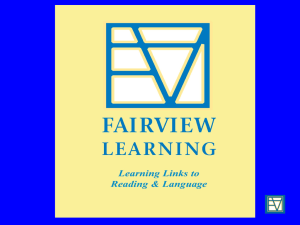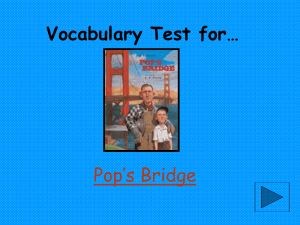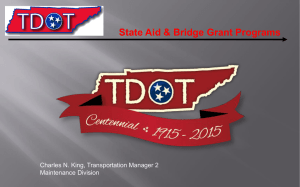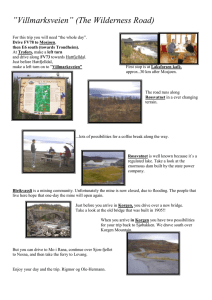FV-Brief-Intro-3_111
advertisement
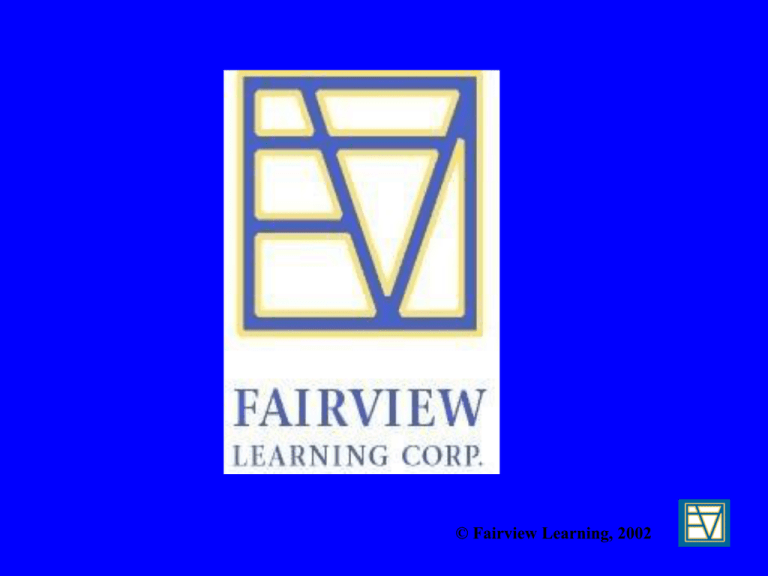
© Fairview Learning, 2002 Fairview Learning • improves the reading skills of students • supported by valid research • provides adapted materials • relies on team approach • maximizes the Visual Linguistic System • advocates fun in the classroom! © Fairview Learning, 2002 FAIRVIEW LEARNING 5 PROGRAM COMPONENTS The Adapted Dolch Word Lists The Bridge Lists & Reading Comprehension Phonemic Awareness Literature-Based Instruction ASL Development/Written English ASSESSMENT, ASSESSMENT, ASSESSMENT © Fairview Learning, 2002 The method constantly checks for student learning. © Fairview Learning, 2002 © Fairview Learning, 2002 The Adapted Dolch Word Lists • Deaf children and hearing children do not learn the Dolch words the same way. •To truly comprehend print, the student must sign the Dolch words using ASL concepts. © Fairview Learning, 2002 “I made a present for you.” “I made my bed.” “I made money.” “I made her happy.” “My brother made me do that.” © Fairview Learning, 2002 ^ OUT 3 refers to place refers to amount emphatic out The ^ (rooftop) alerts the learner that the word has multiple meanings. The 3 (number) tells the learner how many meanings are present. © Fairview Learning, 2002 * go 5 Index fingers move out & down 5 to 0 Hand sweeps away Index fingers roll away from body fs The * alerts the learner that the word can be signed multiple ways, but all signs mean the same. The number indicates the number of signs presented. © Fairview Learning, 2002 ! Put The ! alerts the learner that the handshape usuallly stays the same, but the motion, direction, and/or expression changes depending on context. © Fairview Learning, 2002 Adapted Dolch Words Preprimer Primer 1st Grade Words 40 49 40 45 39 Meanings 71 74 66 73 66 Signs 95 113 110 112 80 2nd Grade 3rd Grade Total Signs = 510 A hearing student will learn 40 Dolch words, but a Deaf student will learn 71 meanings along with 95 signs for those 40 words. © Fairview Learning, 2002 Online Progress Reports Teachers and students can graph their progress for classroom displays, IEPs, and other reports. These graphs make progress VISUAL and MOTIVATING. © Fairview Learning, 2002 Student Progress Checks Easy to use progress forms are available in Student Progress Folders for record keeping. © Fairview Learning, 2002 Adapted Dolch Words -- Materials Adapted Dolch Word Cards -- Teacher set Adapted Dolch Word Cards -- Student set Adapted Dolch Word Teacher Workbook Adapted Dolch Word Student Workbook Adapted Dolch Word DVD 1 Adapted Dolch Word DVD 2 © Fairview Learning, 2002 © Fairview Learning, 2002 The Bridge Lists • English phrases requiring American Sign Language (ASL) translation for understanding. • Bridging - pointing out and emphasizing Bridge phrases to deaf students. • Bridging when reading allows deaf students access to written English. © Fairview Learning, 2002 [just about] almost Just has 4 signs: recently, exactly, only, fair. About has 2 signs: about and approximate. No combination of these signs makes sense to the visual linguistic system; therefore another sign, almost, is required and indicated by brackets [ ]. © Fairview Learning, 2002 [right over there] F off nose Right has 3 signs: correct, right as in a trial, and right as in turn right. Over has 5: over, over the top, finish, again and again, and cross over the fence. There has 2 signs which mean the same. No combination of these signs makes sense to the visual linguistic system; therefore another sign, F off the nose, is required and indicated by brackets [ ]. © Fairview Learning, 2002 Bridge Lists How do I pretest? • Pretest individually. Select 10 cards from Preprimer deck. If correct, continue. After 5 incorrect responses, STOP. Graph, if appropriate. Group students according to list levels. • Fun ways to teach include: Pictionary, Charades, Sentence Manipulation, Bridge Bowls Workbooks © Fairview Learning, 2002 The Bridge Lists 58 1st Grade 51 2nd Grade 45 3rd Grade 40 117 94 124 66 54 153 123 158 70 75 Preprimer Primer Phrases 71 Meanings Signs Total Signs = 579 © Fairview Learning, 2002 Bridge Lists -- Materials Bridge Lists Cards Teacher set Bridge Lists Cards Student set Bridge Lists Teacher Workbook Bridge Lists Student Workbook Bridge Lists DVD 1 Bridge Lists DVD 2 © Fairview Learning, 2002 Phonemic Awareness • Skilled deaf readers make use of phonological information. • All of us have our own phonemic vocabularies, right or wrong. • All readers possess a basic code to decode the printed word. © Fairview Learning, 2002 Phonemic Awareness & Vowel Patterns CONSONANTS VOWELS b d f Short g h j _a_ a_e, ai, ay k l m _e_ ee, ea, ey, _e n p r _i_ i_e, igh, _y s t v _o_ o_e, oa, _o, ow _u_ u_e, ew w z th Long wh ch sh © Fairview Learning, 2002 Why Phonemic Awareness and Patterns Work Seeing patterns in words takes advantage of M space, especially in very young children. • igh –1 space, not 3 • A 7-year-old child has 3 M spaces; therefore, only 1 space is occupied by igh and 2 are free for easier processing. © Fairview Learning, 2002 Literature-Based Instruction Adapted Dolch Words, Bridge Lists, and Phonemic Awareness provide the FOUNDATION for reading print conceptually with comprehension. These tools make print materials accessible, relevant, and fun. © Fairview Learning, 2002 Amelia Bedelia Put the lights out when you finish in the living room. (???) Various texts are utilized in trainings to demonstrate the application of the Adapted Dolch words, Bridge Lists, and Phonemic Awareness. © Fairview Learning, 2002 Amelia Bedelia [Put the lights out] when you finish in the living room. For example, “Put the lights out” must be bridged to check for text comprehension. © Fairview Learning, 2002 ASL Development In trainings techniques are presented to develop student ASL skills with student signing samples. • Students sign personal stories to the ASL instructor. • The ASL instructor retells the stories modeling proper ASL. • Students then sign their stories again, implementing proper ASL structures. • Students record and illustrate their stories to demonstrate progress. © Fairview Learning, 2002 Spontaneous Written English In trainings techniques are presented to develop student writing skills with student writing samples. • During writing time, the student dictates and/or writes spontaneous and personal short stories with their teachers. • These stories are translated into proper English. • The student then copies and/or types the proper English version and illustrates the stories. • Language Experience Folders are available for recording progress. © Fairview Learning, 2002 Student Sample Said open cabinet get food breakfast Get ice mother stare Said go put food later eat Said stubborn and immature Mother insulted. Spell m-u-l-e. Mother oh. I said sorry. ------------------------------------------------------------------------------------- Teacher/Student Revision I [opened the cabinet] [to get] breakfast food. I got ice and mother [stared at] me. She said, “Go put the food back. Later you will eat.” I said she was stubborn and immature. Mother was insulted. I spelled m-u-l-e. Mother said, “Oh!” I said, “I am sorry.” © Fairview Learning, 2002 ASSESSMENT, ASSESSMENT, ASSESSMENT • Immediate Positive feedback is motivational. Secondary School -- Bridge List Comparisons (1999-2000 School Year) 4 4 3 Bridge Lists Levels • Makes it more FUN to learn. 4 3 3 3 2 2 2 1 Proficient 2 ASL Average Progress (on 8 Criteria) for all Grades (1999-2000 School Year) 5 0 7 Nearly Proficient 8 9 11 4 -1 Uses More Often Than 3 Not 1 rip tio n yo fD es c Sta yin go nT op ic Se qu en cin g erb s Us e Grade Level • Meets IEP Requirements – goal setting. 8 Criteria 8 7 Pre Assessment Post Assessment 6 6 5 5 4 4 Elementary School - Adapted Dolch Word Lists Progress 4 3 (1999-2000 School Year) 3 2 4 4 2 3 1 Grade Level of Word Lists • Provides accountability for all participants. 7 4 4 on al V 8 8 Inte ns it 8 of Dir ec ti 9 ion et Up ifie rs Cla ss • Encourages healthy competition. Expected Grade Level Secondary School Reading Comprehension Progress (1999-2000 School Year) 0 11 10 Final Grade Level Bo dy La ng ua ge 12 xp res s None Beginning Grade Level 2 Fa cia lE Emerging N = 34 Average Student Progress by Grade Level Progress in grade levels Sp ati al S • Increases enthusiasm. Uses Frequently 3 3 3 0 7 8 2 9 11 2 Beginning Grade Level 1 Final Grade Level 2 2 Expected FLE 1 1 1 1 1 0 Grade level 1 0 2 3 4 5 6 -1 -1 Students by Grade Level Ave.Progress • Documents efforts of consistent linguistic input. • Promotes parent involvement and satisfaction. • Shows documentation of student progress. N = 34 Average Progress by Grade Level 2 2 2 Beginning Grade Level N = 56 Final Grade Level Expected Grade level Composite Scores (Average of 8 Criteria) for Spontaneous Written English (1999-2000 School Year) Proficient 5 Nearly Proficient 4 Uses More Often Than Not 3 Uses Frequently 2 Emerging 1 None 0 Lower Elementary (1-3) Upper Elementary(4-6) Pre Assessment © Fairview Learning, 2002 Post Assessment Secondary For more information: www.fairviewlearning.com 601-366-4099 © Fairview Learning, 2002
